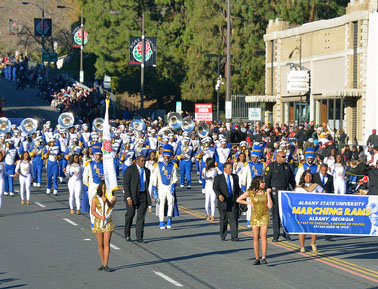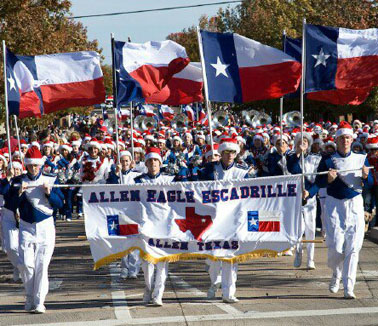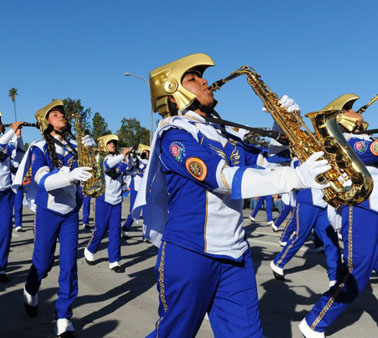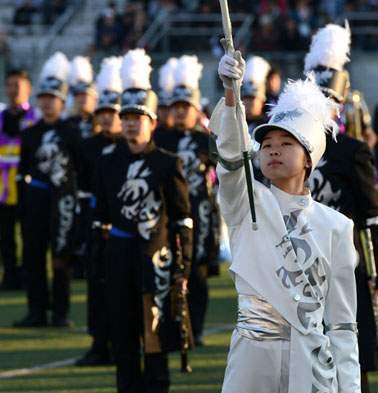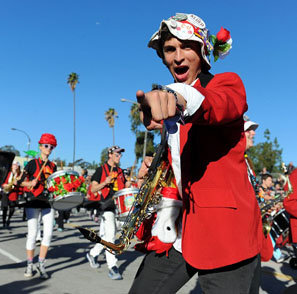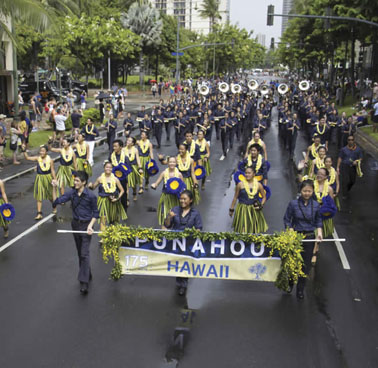What can the Rose Parade tell us about where America is going in 2016?
Jan 7th, 2016 | By Citizen X | Category: In Brief
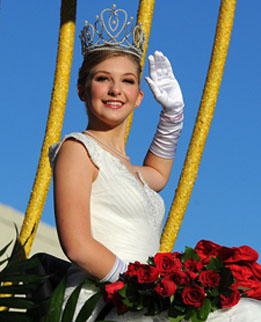
Rose Queen Erika Winter on her float in the 127th Rose Parade in Pasadena, California, January 1, 2016.
The editors say our ongoing main interest on this site in 2016 will be everything American, leading up to the US Â federal election on Tuesday, November 8.
(Though with of course a keen supplementary interest in just how the new Trudeau federal government in Canada is working out – and the regionally diverse Canadian economy.)
So on January 1, 2016 I sat down in front of my favourite big TV to watch the Rose Parade from Pasadena in Los Angeles County. In this “127th Rose Parade presented by Honda,” I thought, there will be some grist for mills of thought anxiously trying to fathom the increasingly new and unsettling mystery that may or may not be the USA today.
(And as just a most recent taste etc, see this Associated Press report from January 3 : “Oregon federal building occupied by militia protesting prison sentence of ranchers … new sentences touched a nerve with far right groups who repudiate federal authority.”)

Young man in Kailua, Hawaii (where President Obama spends Christmas) eats healthy breakfast before watching Rose Parade on TV.
I used to think the parade was called the Rose Bowl Parade, and meant as a warm-up to the big college football game, also played on January 1 in Pasadena. (And the Rose Bowl on black-and-white TV was a childhood feature of frosty New Year’s days at my aunt and uncle’s old house on Ossington Avenue, just north of Bloor Street, in Toronto, Ontario, Canada.)
In fact, what is properly called the Rose Parade (or the Tournament of Roses Parade) was “founded in 1890 … by Pasadena’s recently-formed Valley Hunt Club.” This led to “the formation of a new Tournament of Roses Association in 1895 … that still handles the organization of the parade today.”
Meanwhile, the parade got underway at 8 AM local Pacific time, at the corner of Green Street and Orange Grove Boulevard in Pasadena. This was already 11 AM back here in our local Eastern daydream. And it took me a while to catch up. Even now you can still “Watch the 2016 Rose Parade Replay” from KTLA in Los Angeles. (And for a few hints of what you’ll miss if you don’t do this, click on “Read the rest of this page” and/or scroll below.)
“I Love A Parade”
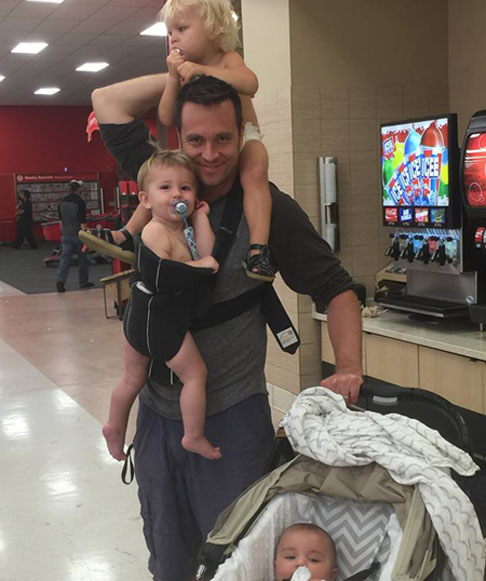 I should make clear up front that, for better or worse, I am the kind of person who loves a parade.
I should make clear up front that, for better or worse, I am the kind of person who loves a parade.
I grew up in a family of old-school Canadian militia musicians. (Where “militia” is not at all the same as in “occupied by militia protesting prison sentence of ranchers” south of the border today.) Watching parades with marching bands was a nostalgic part of my childhood. And then in my youth I played myself in football marching bands, in both high school and college.
Another related childhood artifact I can remember is a 78 rpm American record in orange vinyl called something like “I Love a Parade.” (I think – but not the later Walt Disney concoction under that name.) My father bought it for my brothers and I, at a Toronto record store on Vaughan Road, just south of St. Clair.
At one point the cheery voice on the record said something like “Here come the Marines,” followed by a rousing chorus of “From the halls of Montezuma / To the shores of Tripoli / We will fight our country’s battles / On the land and on the sea.”
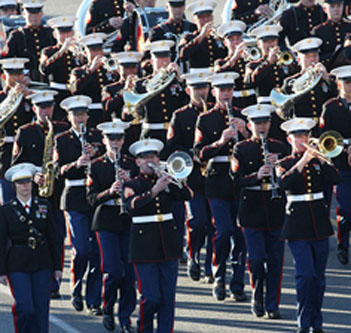
The United States Marine Corps West Coast Composite Band in the 127th Tournament of Roses Parade in Pasadena.
It all came back to me when the US Marine Corps West Coast Composite Band arrived early on in the 2016 Rose Parade, playing their own rousing version of The Marines’ Hymn.
The Marines were soon followed by something altogether amazing called The Allen Eagle Escadrille – or the Allen High School marching band from Allen, Texas. This includes “the Band, the Color Guard, and the Tallenettes (drill team).” It “claims to be the biggest marching band in the country.” (And with an astounding 782 members out for the 2016 Rose Parade this claim certainly seems plausible.)
With the Allen Eagle Escadrille, playing “Deep in the Heart of Texas,” I did feel we were getting close to what I was looking for. It reminded me of the late English literary critic Cyril Connolly on America’s “demonic energy and taste for the colossal.”
(How much more colossal can you get than a 782-member marching band – even with the Color Guard and the Tallenettes? Which also reminds me that the late Cyril Connolly’s “literary papers” are held by the University of Texas at Austin. Who says [some] Texans do not also believe in the finer European arts and crafts?)
Other US (and other) marching bands …
The American marching bands on display in the Rose Parade today are not quite like the Canadian militia bands I grew up with in Toronto, just after the Second World War.
The old Canadian militia bands were creatures of the global British empire, and their musical style reflected august imperial (and aristocratic) assumptions. American military music has always been more democratically energetic and colossal than its British forefather (and/or mother too?) – and more obsessed with technical fireworks and mechanical perfection.
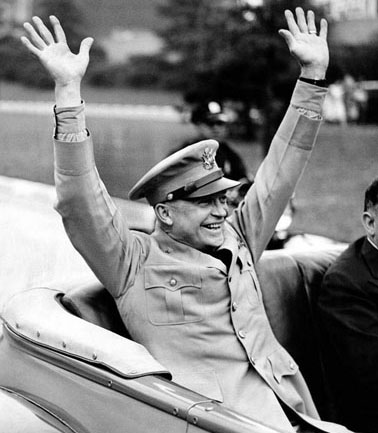
General Dwight D. Eisenhower acknowledges cheers of New York crowd in “Victory in Europe” parade at end of Second World War, June 6, 1945.
The North American football band – a kind of modern or even postmodern extension of the European military band – has its own folkways. And in Canada in this case American models have always been more influential than British models. (Since football itself is a different game on either side of the Atlantic, no doubt.) But high school and college football bands in Canada tend to be  less energetic and colossal than in the United States – a way in which the deeper Old World heritage in the northern woods (and the northern climate?) hangs on.
Along with the US Marine Corps West Coast Composite Band and the Allen Eagle Escadrille, the Los Angeles Times listed more additional marching bands than you can count on your two hands and one foot in the 2016 Rose Parade. Here’s my own quick and dirty tabulation in alphabetical order, with brief notes where appropriate (for more extensive treatment see the YouTube video “Marching Bands of the 2016 Pasadena Tournament of Roses Parade”) Â :
* Aguilas Doradas Marching Band, Puebla, Mexico – Like Canada, Mexico has its own (considerably more interesting) version of the North American football band. But it still doesn’t have a team like the Blue Jays in, as they say, “Major League Baseball (MBL)” or the NBA. Why not? See, eg, from just this past July : “California Hispanic population outstrips white: Census.”
* Albany State University Marching Rams (Georgia) – As fans of the movie Drumline will appreciate, African American musical culture has created its own hip variation on the North American football band. And the Albany State University Marching Rams from Georgia brought this particular excitement to the 2016 Rose Parade.
 * Etiwanda HS Marching Eagle Regiment
* Etiwanda HS Marching Eagle Regiment
* Franklin Regional High School Panther Band, Murrysville, Pa.
* L.A. Unified School District All-District High School Honor Band
* Mira Mesa High School Sapphire Sound, San Diego
* Pasadena City College Tournament of Roses Honor Band
* Plymouth-Canton Educational Park Marching Band
* Punahou Marching Band, Honolulu – the band from President Obama’s high-school alma mater in Hawaii (for which he played basketball himself). It says something about something, I think, that neither of  Bob Eubanks or Stephanie Edwards, the long-serving but now about-to-retire Rose Parade TV hosts, brought the president’s connection to Punahou to the attention of the TV audience (so far as I could tell in any case). Even though the band had already appeared in President Obama’s 2013 inaugural parade in Washington, DC. And its director had told an interviewer : “Having the students realize that the President of the United States had eaten in their cafeteria as a student and checked out books from the same library was amazing. These students share an amazing link with the President that is extremely inspirational.”
* Saratoga High School Marching Band and Color Guard, Saratoga, Calif.
* The Salvation Army Tournament of Roses Band
* Toho High School Green Band, Nagoya, Japan – Japan is the one “foreign” country with a noticeable recurrent role in the early 21st century Rose Parade. Just to start with, nowadays it’s the “127th Rose Parade presented by Honda.” The first big float for 2016 was “American Honda: ‘Nature’s Hope,’ Phoenix Decorating Co.” As best as I could make out, it included at least a  short message in Japanese. The Toho High School Green Band (or “Toho Wind Ensemble” as their banner says in English) also follows all the most fastidious Rose Parade traditions (although they do add some impressive fancy marching), in a way some might say today’s Stanford University band ought to emulate. (See below.)
* Trojan Pride band, Jenks, Okla.
* Virginia Military Institute Regimental Band and Pipes, Lexington, Va.
* William Mason High School Marching Band, Mason, Ohio
* Wyoming All-State Marching Band
* 102nd Rose Bowl Game Stanford University band (aka Leland Stanford Junior University Marching Band) – It also says something about something that the present-day Stanford football band from Palo Alto, intellectual capital of the Internet etc, is an aspiring satirical critique of the traditional Rose Parade style. And not everyone approves.
What does this mean? As just one illustration, take the matter of keeping your lines straight while marching – which, almost everyone agrees (or used to), is at least an important ideal for any serious marching band.
In the British tradition that has been so influential in Canada a gentleman (or lady) will give keeping the lines straight a good old-school try. But it’s not something that one ought to worry about unduly. There are more important matters afoot, and so forth. (Like the music, eg.)
In at least the old and still dominant American tradition, the lines are meant to be as straight as an arrow. In a really good marching band – certainly any band worthy of marching in the Rose Parade in Pasadena, California  – that’s how they’ll try very hard to be.
(To test these propositions, compare the 2016 Rose Parade footage here – or here, and “British Army Bands in London … at Old Wembley Stadium in 1981.” There is smart and complex marching in the British case. But the lines do not aspire to quite such obsessively straight [“linear”?] ideals as prevail even now in the Rose Parade!)
The main point about the Stanford Band today, it seems to me, is that, from its place right next to the gods of the new digital technology, it is (constructively?) criticizing the traditional Rose Parade style. And, again, not everyone agrees. Or as social media commentator Kyle Parmley explained this year : “The Stanford band is a joke. That’s just so disrespectful. Essentially spitting on the tradition of everything that is the Rose Bowl.”
The other side of the argument would seem to be that the Stanford band is just what the office looks like today at Google, or Yahoo, or AOL, and all that. And this is where America’s economic leadership rests now. The people who still put straight lines and guns above all other values should just get used to it.
(Though you might also say that the Toho High School Green Band, from Nagoya, Japan, is doing some of what the Stanford band’s antics seem to be pointing to – in more disciplined and  artistic ways? Then there are the different again but still innovative cases of the Aguilas Doradas Marching Band from Puebla, Mexico and the Albany State University Marching Rams from Georgia, etc, etc, etc, etc.)
* 102nd Rose Bowl Game University of Iowa band (from the midwest, and still doing the traditional right thing, even if Stanford still beat them in the 2016 Rose Bowl!).
Roses, oranges, and the 2016 Tournament of Roses skywriting critique of Donald Trump
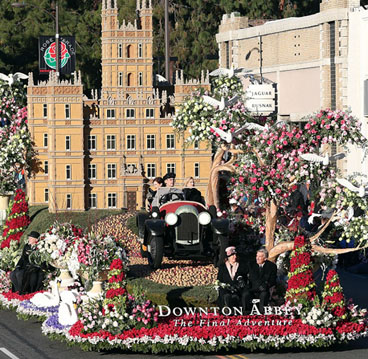
Float for last season of Downton Abbey TV series from the UK in the 2016 Rose Parade – advertising is one thing the event has always been about.
Of course for many observers (and participants) marching bands are not the only or even the most important things in the Rose Parade.
As the “LA Tourist” site explains, in its early days the “main idea behind the parade was for … Â new Californians to showcase their state’s mild winter weather, a place where flowers bloomed all year long, in stark contrast to the places they left in the East and Midwest … Today, the Rose Parade and all the events organized around it draw tens of thousands to the Pasadena area and literally millions sit in front of the television to enjoy state-of-the-art floats with high-tech animation, covered with flowers from around the world.”
Meanwhile, I don’t recall seeing this on TV, but according to subsequent press reports :
* “Skywriters have message for Trump at Rose Parade … Skywriters stole the show at the 127th Rose Parade in California on Friday, dashing out a message for Donald Trump just as the last float left the gate … ‘America is great! Trump is disgusting,’ were the words dotted clearly across the sky on what appeared to be a mostly cloudless morning.” .
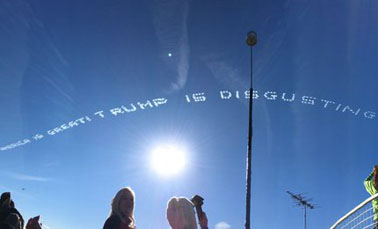 * “Rose Parade turns political as millionaire Rubio supporter pays for five skywriters to spell out Donald Trump insults above crowd …. Authorities said the event would be held under unprecedented security, although there were no known threats … Parade came just a month after a deadly mass shooting in nearby San Bernardino, California … Stan Pate, a millionaire real estate developer, is the man behind skywriters taking over the skies during the parade to write anti-Donald Trump messages … Â The Alabama native said ‘there’s no place’ for Trump and that ‘he’s a despicable man’.”
* “Rose Parade turns political as millionaire Rubio supporter pays for five skywriters to spell out Donald Trump insults above crowd …. Authorities said the event would be held under unprecedented security, although there were no known threats … Parade came just a month after a deadly mass shooting in nearby San Bernardino, California … Stan Pate, a millionaire real estate developer, is the man behind skywriters taking over the skies during the parade to write anti-Donald Trump messages … Â The Alabama native said ‘there’s no place’ for Trump and that ‘he’s a despicable man’.”
What does it mean for the 2016 American election ????
The short answer to this question is of course that I have no serious idea at all … But …
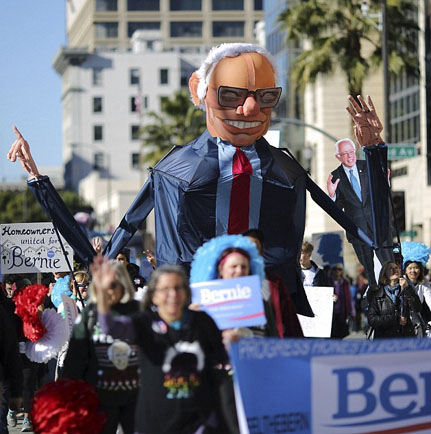
Supporters of US Democratic presidential candidate Senator Bernie Sanders also marched in the 127th Rose Parade!
For starters, some supporters of US Democratic presidential candidate Senator Bernie Sanders also marched in (or at least followed?) the 127th Rose Parade! Again, I don’t recall seeing this on the KTLA TV coverage, but I did find photos on the net afterwards …
And then there was the skywriting against Donald Trump, paid for by a supporter of fellow US Republican presidential candidate Marco Rubio (the really brilliant choice for the Republicans that they probably won’t make in the end?) …
There may be a sense in which the Rose Parade itself has more in common with Ronald Reagan’s California of the late 1960s and early 1970s, than it has with Jerry Browns’s California of either the later 1970s and earlier 1980s or (more importantly) today …
Similarly, if I had to guess I’d guess that  Bob Eubanks and Stephanie Edwards who cover the parade for KTLA vote Republican. But even if this is right, 2016 has been their last Rose Parade. He is 77 and she is 72. Their California is giving way to the California where “Latinos” not “Whites” are the single largest ethnic or cultural group …

This young man in Hawaii is too young to vote and/or march in the Rose Parade. But he does like to be with his mom.
Meanwhile, does the controversy over the Stanford Band have implications for Hillary Clinton? Is she at risk of being abandoned by those who don’t agree with the Stanford critique of traditional Rose Parade values?
The more I think about all this, the more it seems to me that the Rose Parade probably doesn’t tell us all that much about where the USA today is headed politically in 2016 …
I think it does speak to a certain continuing (and even reassuring) vigour in American popular culture. And it suggests that in many ways this culture is changing to reflect just how different America is today from how it was at the end of the Second World War, 70 years ago … And if you are the kind of person who loves a parade, the Rose Parade is still well worth watching on New Year’s Day(even or especially if you live in Canada). And there are still some excellent marching bands in America today (even if most of them have more to do with football than the US military). And that must say something about something too …
